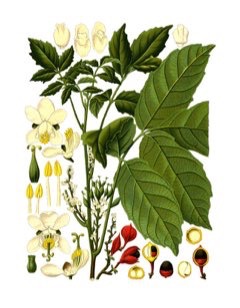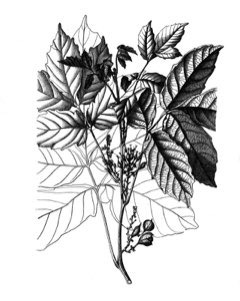 |
|
http://www.edibleplants.org |
 |
| http://www.edibleplants.org |
Translate this page:
Summary
Native to the Amazon, Paullinia cupana or commonly known as Guarana is an evergreen climbing shrub growing about 13m in height. It has large leaves with five leaflets each leaf, and clusters of small, white flowers. The fruits are small, bright red, and splits open when ripe. Guarana is known for its large and black seeds, which contain high concentration of caffeine. Guarana seeds are used medicinally mainly as stimulant, astringent, and analgesic. It is used against diarrhea, fatigue, headaches and migraines, and mild depression. The seeds can be roasted and pounded to make a paste, which is then used to make a drink, or used as bread flavoring. It is used as a dietary supplement, and in carbonated soft drinks and energy shots. Plants are grown from seeds. However, seeds can become non viable after 72 hours in storage so it has to be sown fresh.
Physical Characteristics

 Paullinia cupana is an evergreen Climber growing to 10 m (32ft) by 1 m (3ft 3in) at a medium rate.
Paullinia cupana is an evergreen Climber growing to 10 m (32ft) by 1 m (3ft 3in) at a medium rate.
See above for USDA hardiness. It is hardy to UK zone 10. The flowers are pollinated by Bees.
Suitable for: light (sandy), medium (loamy) and heavy (clay) soils and prefers well-drained soil. Suitable pH: mildly acid, neutral and basic (mildly alkaline) soils. It can grow in semi-shade (light woodland) or no shade. It prefers moist soil.
UK Hardiness Map
US Hardiness Map
Synonyms
Paullinia sorbilis Mart.
Plant Habitats
Edible Uses
Edible Parts: Seed
Edible Uses: Chocolate Coffee Drink
The roasted and pounded seed is made into a paste which is then used to make a stimulating beverage that is rich in caffeine[301 ]. The sweetened paste, called Brazilian chocolate, is used in soft drinks, candy etc[301 ]. The seeds contain 2.7 - 7% caffeine as well as the stimulants theophylline and theobromine[254 , 303 ]. The seeds contain up to 7% of a caffeine-like compound known as guaranine, which is not addictive and takes longer to be metabolized, giving it a gentler, more sustained stimulating effect[238 ]. The seeds are also roasted, pounded, and used as a flavouring in bread[418 ].
References More on Edible Uses
Medicinal Uses
Plants For A Future can not take any responsibility for any adverse effects from the use of plants. Always seek advice from a professional before using a plant medicinally.
Antidepressant Antidiarrhoeal Antipyretic Astringent Bitter Diuretic Febrifuge Stimulant
Tonic
Guarana seed contains xanthine derivatives, including up to 7% caffeine plus theobromine and theophylline; tannins and saponins[254 ]. It is an astringent, bitter, diuretic herb with a strong, stimulant effect[238 , 254 ]. The seed is said to be antipyretic, antineuralgic and antidiarrhoeal, and is also reputed to be a powerful stimulant, an analgesic comparable to aspirin and an anti-influenza agent[303 ]. The Rainforest tribes have used guarana mainly as a stimulant, astringent and in treating chronic diarrhoea[303 ]. The powdered seed is taken internally to relieve fatigue, aid concentration and lift the spirits[238 ]. One report says that overuse can cause sleeplessness, although less so than caffeine-based drinks[238 ], whilst others say that the stimulating effect is due to caffeine[254 , 303 ]. A useful short-term remedy for boosting energy levels, though it tends to inhibit the body's natural restorative processes if used in the longer term[254 ]. The seed is also taken internally in the treatment of chronic diarrhoea; headaches and migraine; and in the treatment of mild depression[254 ]
References More on Medicinal Uses
The Bookshop: Edible Plant Books
Our Latest books on Perennial Plants For Food Forests and Permaculture Gardens in paperback or digital formats.

Edible Tropical Plants
Food Forest Plants for Hotter Conditions: 250+ Plants For Tropical Food Forests & Permaculture Gardens.
More

Edible Temperate Plants
Plants for Your Food Forest: 500 Plants for Temperate Food Forests & Permaculture Gardens.
More

More Books
PFAF have eight books available in paperback and digital formats. Browse the shop for more information.
Shop Now
Other Uses
References More on Other Uses
Cultivation details
Guarana is a plant of the humid lowland tropics, where it is found at elevations up to 800 metres. It grows best in areas where annual daytime temperatures are within the range 24 - 32°c, but can tolerate 18 - 38°c[418 ]. When dormant, the plant can survive temperatures down to about 10°c[418 ]. It prefers a mean annual rainfall in the range 2,000 - 2,500mm, but tolerates 1,100 - 3,000mm[418 ]. It does not like a dry season[303 ]. Prefers a position in full sun, also succeeding in light shade[303 , 418 ]. The plant requires a soil that is deep, medium or heavy in texture, well drained and with high organic matter content[303 ]. Traditionally, plants are grown on very acid soils of low fertility with high concentrations of aluminium[303 ]. It grows naturally on gley soils with a pH in the range 3.5 - 4.5[303 ]. Prefers a pH in the range 4 - 5.5, tolerating 3.5 - 6.5[418 ]. Bloom Color: White/Near White.
References Carbon Farming Information and Carbon Sequestration Information
Temperature Converter
Type a value in the Celsius field to convert the value to Fahrenheit:
Fahrenheit:
The PFAF Bookshop
Plants For A Future have a number of books available in paperback and digital form. Book titles include Edible Plants, Edible Perennials, Edible Trees,Edible Shrubs, Woodland Gardening, and Temperate Food Forest Plants. Our new book is Food Forest Plants For Hotter Conditions (Tropical and Sub-Tropical).
Shop Now
Plant Propagation
Seed - must be sown as soon as it is ripe since it loses viability within 72 hours[303 ]. Germination can take more than 100 days[303 ].
Other Names
If available other names are mentioned here
Guarana, brasilian cocoa, brazilian cocoa, cupana, guaraanaseeme, guarana, guarana (graine de), guarana (paullinia cupana), guarana kletterstrauch, guarana seed, guarana, siemen, guarana-strauch, guaranafrø, guaranasamen, guaranastruik, guaraná, guaraná, semilla de, guaránamag, nasienie paulinii gwarany, pauliniju seklos, paullinia, paullinia cupana seed, paullinia sorbilis, paulliniae semen, paulinijas seklas, seme gvarane, semeno paulinie nápojné, semeno paulínie, uarana, zerriegha tal-gwarana [1-4].
Native Range
SOUTHERN AMERICA: Guyana, Venezuela, Brazil (Amazonas, Pará), Ecuador (Napo), Peru
Weed Potential
Right plant wrong place. We are currently updating this section.
Please note that a plant may be invasive in one area but may not in your area so it's worth checking.
Conservation Status
IUCN Red List of Threatened Plants Status : This taxon has not yet been assessed

Growth: S = slow M = medium F = fast. Soil: L = light (sandy) M = medium H = heavy (clay). pH: A = acid N = neutral B = basic (alkaline). Shade: F = full shade S = semi-shade N = no shade. Moisture: D = dry M = Moist We = wet Wa = water.
Now available:
Food Forest Plants for Mediterranean Conditions
350+ Perennial Plants For Mediterranean and Drier Food Forests and Permaculture Gardens.
[Paperback and eBook]
This is the third in Plants For A Future's series of plant guides for food forests tailored to
specific climate zones. Following volumes on temperate and tropical ecosystems, this book focuses
on species suited to Mediterranean conditions—regions with hot, dry summers and cool, wet winters,
often facing the added challenge of climate change.
Read More
Expert comment
Author
Kunth
Botanical References
Links / References
For a list of references used on this page please go here
A special thanks to Ken Fern for some of the information used on this page.
Readers comment
| Add a comment |
|
If you have important information about this plant that may help other users please add a comment or link below. Only comments or links that are felt to be directly relevant to a plant will be included. If you think a comment/link or information contained on this page is inaccurate or misleading we would welcome your feedback at [email protected]. If you have questions about a plant please use the Forum on this website as we do not have the resources to answer questions ourselves.
* Please note: the comments by website users are not necessarily those held by PFAF and may give misleading or inaccurate information.
To leave a comment please Register or login here All comments need to be approved so will not appear immediately.
|
Subject : Paullinia cupana
|
|
|
|